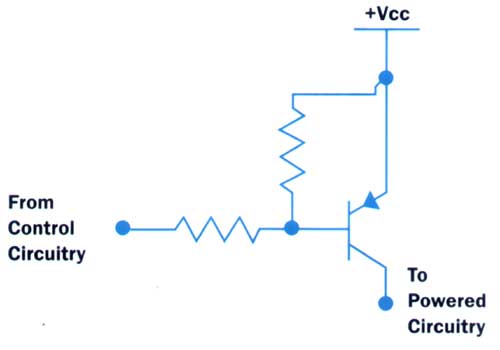There will always be the need to get heat out of high power circuitry, but with a little extra design effort up front, we may be able to reduce overall power needs. Here are two techniques that can help do that.
Turn Idle Circuits Off
A circuit that is not always used can be turned off until needed. This is a technique widely used in battery powered electronics, but it can be used anywhere.
Table 1. Typical circuits and power for a wireless phone.
|
||||||||||||||||||||||||||||||||||||||||||||||||||||||||||||||||||||||||||||
Take the example of a wireless telephone. Typically, the handset is idle or in standby mode. The wireless phone described in Table 1 is idle ~90% of the time. During this time it waits to be turned on or to receive a ringing message from the base unit. When active, which is ~10% of the time, it is either busy with a phone call or ringing the phone. The totals shown are calculated as:
% Time On or Off = (Processor Time + Ringer + Display + Voice + Oscillators + Radio Rec + Radio Tx + Other) x (% Time in State)
For Example:
% Time On (Idle) = [(10% x 5%) + 0 + 0 + 0 + (5% x 5%) + (40% x 5%) + 0 + (5% x 100%)] x .9 = 6.975% or ~7%, and (Relative) % Power Consumption = % of maximum power used in a given state, therefore
Relative Power Consumption (Idle) = [(10% x 5%) + 0 + 0 + 0 + (5% x 5%) + (40% x 5%) + 0 + (5% x 100%)] = .0775, and Relative Power Consumption (Active) = [(10% x 100%) + (10% x 1%) + (1% x 100%) + (5% x 100%) + (5% x 100%) + (40% x 100%) + (24% x 99%) + (5% x 100%)] = .99
Based on these calculations, the overall average power when idle circuitry is turned off is the sum of the relative power times the % time for each state which is = (.0775 x 90%) + (.99 x 10%) = 16.875% of maximum. This is an 83.125% power savings compared to leaving everything on.
Obviously, this type of product demands low power consumption or the customer will complain that the batteries do not last. However, this design strategy can be used on any type of electronic product regardless of the power needs. It not only saves power and reduces heat but it usually reduces emissions and increases the life of the product.
An example circuit implementation appears in Figure 1. This shows a transistor implementation, but, depending on power needs, a FET or relay can also be used. The control circuitry (microprocessor, etc.) determines when the powered circuitry should be on or off.
 |
Figure 1. Circuit implementation.
Reduce the Average Power Consumption
When a circuit cannot be turned off, the designer should look to reduce the power. One way is through multiplexing and demultiplexing. For example, a processor needs to monitor several circuits and has a port to each one for that communication. Instead of using a dedicated port for each circuit, the designer could use one port and a multiplexer to route each link to that single port. This not only saves power but cost.
Another technique is to use a demultiplexer. Anyone who has ever been to a large food or department store has seen a bluish – green display on the cash register. To reduce the power consumption in these displays, each character is turned on and off one at a time sequentially until all have been turned on once and then the process is repeated. To the customer, it appears that the entire display is on because this process happens faster than the eye can detect. This has become so common that most displays are now designed this way. If each display has 40 characters and each character uses ~0.1 watts, then:
Power Savings = [40 characters x .1 Watts] – [1 character x .1 Watts] = 4 Watts – .1 Watts = 3.9 Watts(= 97.5% power savings)
Summary
In summary, the old saying “an ounce of prevention is worth a pound of cure” certainly applies to the thermal gains that may be realized when more design effort is put in up front.






